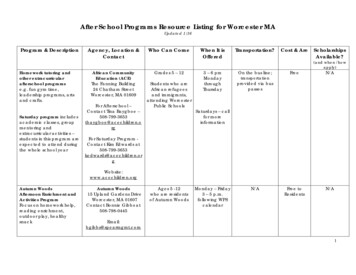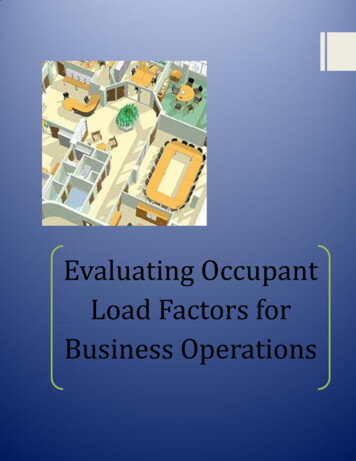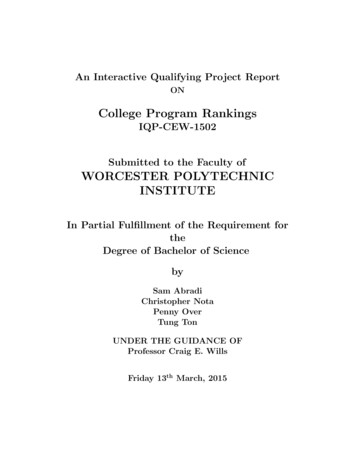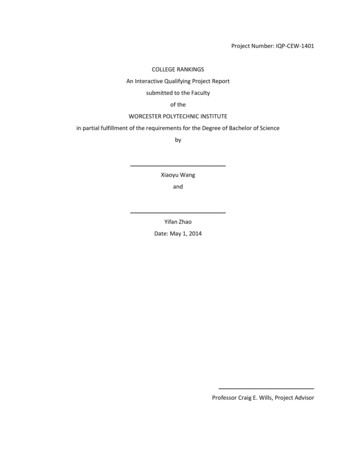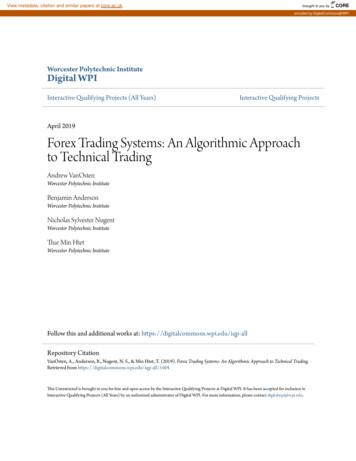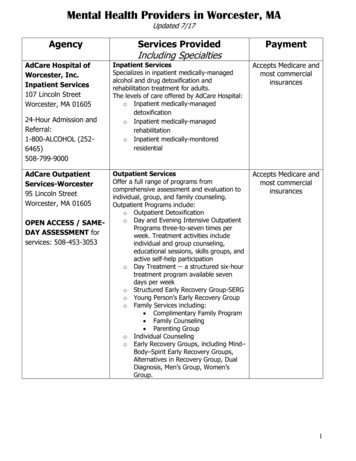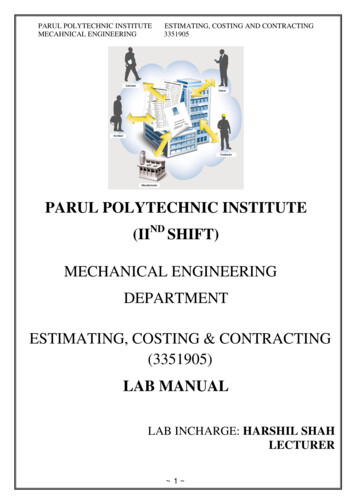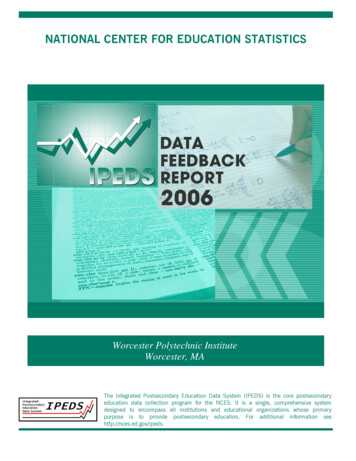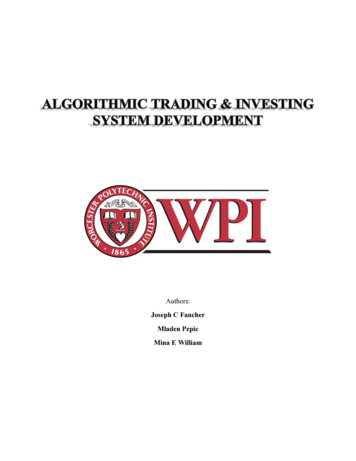
Transcription
Authors:Joseph C FancherMladen PepicMina E William
Algorithmic Trading & Investing System DevelopmentInteractive Qualifying Project, WPIFancher, Pepic, WilliamAn Interactive Qualifying Projectsubmitted to the Faculty ofWORCESTER POLYTECHNIC INSTITUTEin partial fulfillment of the requirements forthe degree of Bachelor of ScienceBy:Joseph C FancherMladen PepicMina E WilliamDate:May 12, 2016Report Submitted to:Dr. Michael RadzickiDr. Hossein HakimWorcester Polytechnic Institute, Worcester, MA 01609This report represents work of WPI undergraduate students submitted to the faculty as evidence of a degreerequirement. WPI routinely publishes these reports on its web site without editorial or peer review. For moreinformation about the projects program at WPI, see http://www.wpi.edu/Academics/Projects.1 Page
Algorithmic Trading & Investing System DevelopmentInteractive Qualifying Project, WPIFancher, Pepic, WilliamACKNOWLEDGMENTSOn behalf of Joseph Fancher, Mladen Pepic, and Mina William, we as a team would liketo acknowledge our two extremely intelligent and influential advisors: Dr. Michael J Radzickiand Dr. Hossein Hakim. We would like to thank them for their guidance, support, and motivationthroughout the completion of this project. Not only did they share with us their experience andintelligence in teaching us the needed backbone components of this project, they also gave us abroader vision and desire to further pursue more knowledge in the world of finance.Lastly, we would like to thank both TradeStation Inc. and our institution, WorcesterPolytechnic Institute, for their services as well as the opportunity of working on and completingsuch a rigorous, yet amazing and life-changing Interactive Qualifying Project.2 Page
Algorithmic Trading & Investing System DevelopmentInteractive Qualifying Project, WPIFancher, Pepic, WilliamTABLE OF CONTENTS1 Introduction & Overview of Research . 71.1Statement of the Problem . 71.2Statement of Problem Importance . 71.3Summary of Literature & Statement of Creativity . 81.4Summary . 92 Trading & Investing . 112.1Retail Trader vs. Investor . 112.2Introduction to Basic Macroeconomics . 122.3The 4 asset groups classes . 132.3.1Stocks . 132.3.2Currencies . 132.3.3Bonds and commodities . 142.4Inter-market Analysis . 142.4.1Stocks . 142.4.2Advantages and Disadvantages of Stocks. 152.5Breadth of the Market . 163 Trading Systems . 173.1Trading Platforms . 173.2Strategies and Other Logic . 173.2.1Trend Following Systems . 183.2.2Volatility Expansion Systems . 183.2.3Support & Resistance Systems . 193.3Automatic v. Manual Trading . 193.4Fundamental v. Technical Trading . 193.5Rules for Trading Systems . 213.5.1Entry Rules. 213.5.2Exit Rules . 213.5.3Position Sizing Rules . 223.6Order Types . 223.7Trend Following Strategies . 223 Page
Algorithmic Trading & Investing System DevelopmentInteractive Qualifying Project, WPIFancher, Pepic, William3.8Gap Strategies . 234 Optimizing and Analyzing Trading Systems . 254.1Optimization . 254.2Work-Forward Analysis . 264.3Expectancy, Expectunity, & System Quality . 284.4Monte Carlo Analysis . 294.5System of Systems . 305 Literature Review . 316 Fancher’s Trading System . 336.1System Development . 336.2System Description . 376.3System Analysis . 417 William’s Trading System . 527.1System Development . 527.2System Description . 537.3System Analysis . 558 Pepic’s Trading Strategy . 678.1System Development . 678.2System Description . 708.3System Analysis . 729101112System of Systems . 80Summary & Conclusion . 84Works Cited . 86Appendices . 884 Page
Algorithmic Trading & Investing System DevelopmentInteractive Qualifying Project, WPIFancher, Pepic, WilliamTABLE OF FIGURESFigure 1: Segmented Walk-Forward Optimizer Example . 27Figure 2: Example of Buy and Hold System . 35Figure 3: Example of Buy and Sell System . 36Figure 4: Market Trend and Momentum . 38Figure 5: Joe’s Trading Chart . 40Figure 6: Joe’s Trading Rules . 41Figure 7: Joe’s TradeStation Summary Report . 42Figure 8: Joe’s TradeStation Equity Curve . 44Figure 9: Joe’s System Cluster Walk Forward Results . 45Figure 10: Joe’s System Cluster Walk Forward Efficiency Results . 45Figure 11: Joe WFO Test Criterion . 46Figure 12: Walk-Forward Optimized Equity Curve . 46Figure 13: Monte Carlo Analysis . 48Figure 14: Monte Carlo Confidence Cone . 49Figure 15: Equity Curve Before Fixed Fractional Position Sizing . 50Figure 16: Equity Curve After Fixed Fractional Position Sizing . 50Figure 17: Joe’s System Quality analysis . 51Figure 18: Mina's GOOGL Stock Chart . 57Figure 19: Mina's TradeStation Summary Report . 58Figure 20: Mina's TradeStation Equity Graph . 59Figure 21: Mina's Walk-Forward Analysis Results . 605 Page
Algorithmic Trading & Investing System DevelopmentInteractive Qualifying Project, WPIFancher, Pepic, WilliamFigure 22: Mina's Walk-Forward Efficiency Results . 60Figure 23: Mina's Confidence Cone . 61Figure 24: Mina's Monte Carlo Confidence Cone . 62Figure 25: Mina's Monte Carlo Analysis Results . 63Figure 26: Mina's GoogL Equity Curve . 64Figure 27: Mina's GOOGL Position Sizing . 65Figure 28: Mina’s System Quality analysis . 66Figure 29: Gap Example . 69Figure 30: Dollar Trailing Example . 70Figure 31: Mladen's Trading Rules . 71Figure 32: Mladen’s TradeStation Summary Results . 73Figure 33: Mladen's Walk Forward Analysis Results . 74Figure 34: Mladen's Walk Forward Efficiency Results . 75Figure 35: Mladen’s Optimized Equity Curve. 75Figure 36: Mladen's Equity Curve . 76Figure 37: Mladen's Equity Curve After Position Sizing . 77Figure 38: Mladen's Monte Carlo Confidence Cone . 78Figure 39: Mladen's System Quality analysis . 79Figure 40: System of Systems Equity Curve . 81Figure 41: System Quality Comparison Table. 82Figure 42: System of Systems Monte Carlo Confidence Cone . 82Figure 43: System of Systems Monte Carlo Results . 836 Page
Algorithmic Trading & Investing System DevelopmentInteractive Qualifying Project, WPIFancher, Pepic, William1 INTRODUCTION & OVERVIEW OF RESEARCH1.1 STATEMENT OF THE PROBLEMThe purpose of this Interactive Qualifying Project (IQP) is to equip the team members withinformation and experience with stock market automatic trading. The project combined the workof three different trading strategies that were implemented into a system of systems to create atrading portfolio. Each system had its own parameters and time frames that collectivelysimulated trades with artificial money. This research paper describes, analyzes and tests eachsystem separately, as well as the whole system of systems.1.2 STATEMENT OF PROBLEM IMPORTANCEFinancial stability is the most common concern among citizens of any economical state.Learning and managing a financial portfolio is extremely important for one’s future. The stockmarket is a great mean for individuals to start future investing, as long as they have the properknowledge to secure their investments. The Internet provides investors and traders with theability to trade from their home. There are many online trading platforms, which tends to hurtindividuals who lack the proper training and strategizing skills for maintaining a profitableportfolio. It is estimated that “84% of all stocks are traded using high-frequency computers”(Washingtons Blog). Lack of knowledge induces risk, which has proven detrimental to one’sassets; this as a result leads to troubled savings for many individuals out there.Personal saving is a major key in one’s retirement, leaving money in a bank alone is notas profitable as actively investing it. Knowing that, and with the help of electronic trading,trading popularity has increased and prospered. From the constant increase in active trading,7 Page
Algorithmic Trading & Investing System DevelopmentInteractive Qualifying Project, WPIFancher, Pepic, Williammore programs for raising awareness on risks, teaching skills, and implementing strategies haverisen.The main goal of this IQP is to create a system of systems that would trade on aprofitable margin within a specified time frame. Three systems were merged together to create atrading portfolio that users could start investing with. Each group member analyzed stockpatterns, tested different strategies, and used different indicators. Once each system was provento generate profit, it was combined with the others, and used for specific stocks that followed thegeneral pattern of the system.1.3 SUMMARY OF LITERATURE & STATEMENT OF CREATIVITYOur team developed a profitable diversified system of systems that utilized the work ofprevious professional traders and investors. It contains a two moving average crossover strategyoperating on daily bars, a one moving average crossover strategy operating on daily bars, and agap up and down strategy operating on 60-minute bars. The derivation of the strategies will beexplained in depth in the upcoming chapters. Of the many professional investors we acquiredinformation from is Charlie Wright. In his book, Trading as a Business, he gives a deepunderstanding of trending markets; in which two systems utilizes them. He states that trendingmarkets sustain a large increase/decrease in price over a considerable amount of bars. He alsostates that the price movement indicates the direction. Based on his explanation, the averagemoving strategies were modified to detect the direction of the market, and lock a position giveninformation from previous data.8 Page
Algorithmic Trading & Investing System DevelopmentInteractive Qualifying Project, WPIFancher, Pepic, WilliamOur IQP team had little to no knowledge of trading at the beginning of the term. We wereadvised to use previous strategies to better advance our knowledge, as well as try to changeparameters to give those strategies an edge in the market. For example, the two average movingcrossover strategy was implemented from the previous work of Frederic Palmiden, aTradeStation expert and developer. The system was used on different stocks, with differentparameters, as well as turning off the short-sell trigger in the system. It is advantageous to testand use other’s systems, as long as one could improve on it and try to maximize its profit margin.1.4 SUMMARYThe purpose of this IQP was to equip our group with financial knowledge about trading,investing, and portfolio management to create a systematic profit. At the beginning of this IQP,the team had little to no knowledge of the logistics of the market. But through the help andsupport for our advisors, we were able to gain insightful information that will benefit us farbeyond this learning experience, as well as knowledge on how to build a profitable tradingsystem. Over the course of the year, we were equipped with knowledge on how to read graphs,understand the market, and think systematically to prevent losses. After many attempts of trialand error, and complexity build up, we developed three systems: A Gap Strategy, A MovingAverage Strategy, and a Crossover strategy. Our team developed a profitable diversified systemof systems that utilized the work previous professional traders and investors. It contains a twomoving average crossover strategy operating on daily bars, a one moving average crossoverstrategy operating on daily bars, and a gap up and down strategy operating on 60-minute bars.The derivation of the strategies will be explained in depth in the Strategy sections below. Of themany professional investors we acquired information from is Charlie Wright. In his book,9 Page
Algorithmic Trading & Investing System DevelopmentInteractive Qualifying Project, WPIFancher, Pepic, WilliamTrading as a Business, he gives a deep understanding of trending markets; in which two systemsutilize them. He states that trending markets sustain a large increase/decrease in price over aconsiderable amount of bars; and the direction is indicated by price movement. Based on hisexplanation, the average moving strategies were modified to detect the direction of the market,and lock a position given information from previous data.10 P a g e
Algorithmic Trading & Investing System DevelopmentInteractive Qualifying Project, WPIFancher, Pepic, William2 TRADING & INVESTING2.1 RETAIL TRADER VS. INVESTORInvesting is the idea of gradual build-up of wealth over longer extended period of times.This is achieved by buying and holding securities, such as futures, stocks and options. They arelong-term profit seekers, in which they make most of their profits through compounding, andreinvesting their previous profits into additional securities. They hold their investment for years,and sometimes even decades. Taking stock as an example, these “investors view themselves asthe partial owners of the company they are investing with,” (Extension) as well as alwayspredicting success of that company by following current news and other informative means.They are expected to be in the market through inevitable fluctuation, and “ride out” any waves inthe market. The main advantage of investing is that it yields such higher profits on the long run,compared to trading. It requires less effort to be in the market, since they are consistent with thecompany of choice. However, if the company invested in did turn out to fail, they couldpotentially lose all their profit and their invested money as well. They tend to look for a 10% to15% profit annually on investment.Traders on the other hand, are frequent buyers and sellers of securities. They purchasethose things as a mean to capitalize on a shorter-term fluctuation to generate a profit. They do notview themselves as owners of the companies they hold stocks with, however, they look forstocks that contain certain pre-set profiting characteristics. They exploit previous data, and watchfor recurring signals, whether it is success or fail for the company. Compared to investors, whowill wait out the periods of losses with the outlook that the market will rise again, traders will11 P a g e
Algorithmic Trading & Investing System DevelopmentInteractive Qualifying Project, WPIFancher, Pepic, Williamidentify the loss, reset their trading strategies and systems, and enter a different company/market.The main advantage for traders is that they are able to generate profits in shorter periods of time.They do not generate huge long-term profits, and usually look for 10 percent monthly profit.2.2 INTRODUCTION TO BASIC MACROECONOMICSIn the study of macroeconomics, which is a field of economics that studies behavior ofthe aggregate economy and examines economy-wide structures such as unemployment nationalincome, and price levels. In terms of business, two terms always arise, trend vs. cycle. A trend isa general direction that a variable is moving over time. In stocks for example, a market isdescribed in terms of trends. A trend could either be upwards or downwards. On a related note, abusiness cycle is a period of economic growth, that is followed by an economic withdraw. It isdefined as a cycle of it repeats over a period of time (Dollars and Sense).In terms of equities, and future markets, a bid price is the highest price a buyer is willingto pay, while an ask price is the lowest price a seller is willing to accept. A spread is thedifference between those two, which inversely relates to volume; the number of shares orcontracts bought and sold. There are two methods to trade in stocks, long and short. A long standmeans that the trader is buying a stock at a current price, and anticipating to sell it since the pricewill go higher. However, a trader could also short a trade, which means borrow stocks from abroker, and selling it for a lower price; making the profit due to the price difference. When atrader decides to sell a stock that has been longed, a trader can either place a limit or markerorder. A limit order is a pre-set price that the shares should be sold on, where a marker order isimmediate, and takes the trader out the market whenever decided. To aid in covering losses, a12 P a g e
Algorithmic Trading & Investing System DevelopmentInteractive Qualifying Project, WPIFancher, Pepic, Williamtrader will often use a stop loss, which is a price that is pre-set to close a position if a price fallsunder it. There are four asset classes: Equities (stocks), Bonds, Currencies, and Commodities.2.3 THE 4 ASSET GROUPS CLASSES2.3.1 STOCKSEquities, or stocks, are a representation of a company’s ownership. They are one of themain methods that a company can raise its capital. There are many different sectors of stocksincluding: technology, energy, housing, and many more. The market opens at 9:30 AM andcloses at 4:00 PM Eastern Standard Time. ETFs, or Exchange Traded Funds, tracks a bond,index, currencies, or a group of stocks, and these traded in terms of a representation of a group ofinvestments. As oppose to a mutual fund, ETFs trades as a normal stock without extramanagement fees. On the other hand, mutual funds are money-managers controlled, which isinvested and moves assets around to make profit; requiring a fee to do so. In stocks, options areavailable, which are a financial asset to be traded in the market. It gives the trader the right,rather the obligation, to buy a stock at a pre-set price when the option was bought, also named acall option. A put option however, gives the power to the trader to sell the stock at a pricepreviously set. There are two main equity markets, the NASDAQ and NYSE.2.3.2 CURRENCIESCurrencies are traded in a global decentralized market, known as the forex, or foreignexchange market. They are placed in pairs, and they rise and decline in units of pips. A pip is apercentage in point, which denotes the smallest price a currency pair could potentially make. It isa change in price carried out to two-four decimal places in the exchange rate depending on thecurrencies. They could be traded at any time of day, unlike stocks. They are usually highly13 P a g e
Algorithmic Trading & Investing System DevelopmentInteractive Qualifying Project, WPIFancher, Pepic, Williamleveraged, depending on the broker, which could lead the leverage to be as high as fifty to one.An example for a fifty to one leverage, if a trader has a 100, that means they could trade of upto 5000 of currency!2.3.3 BONDS AND COMMODITIESA Bond is a debt investment in which an investor loans money to an entity, allowing thefunds to be borrowed for a defined period of time at a fixed or variable interest rate. They areused by companies and states to raise money and finance projects. They are defined to be asfixed-income securities. When a company needs to raise money, they issue bonds to investors,rather than borrowing a loan of a bank (Yale). This gives the investor a bond with an interest ratethat will be paid for once the bond is returned. Commodities are basic commerce goods that areinterchangeable with commodities of the same type. They are used as inputs in production ofother goods and serves. Some examples of commodities are: Gold, Beef, and Oil. Their tradesare usually placed through futures contracts on exchange that standardize the quantity andminimum quality a commodity is being traded.2.4 INTER-MARKET ANALYSIS2.4.1 STOCKSThe US economy is a large contributor to the market and it’s movement. However,international affairs are also able to affect the stock market. Many variables are taken intoconsideration when understanding how the stock market changes. Unemployment news, FederalReserve, and even terrorism, are able to shift the market up or down. The market is also highlyinfluenced and controlled by humans, who are emotional, fearful, and easily manipulated. Thiscould be harmful to investors and traders due to the concept that a company’s stock can easily14 P a g e
Algorithmic Trading & Investing System DevelopmentInteractive Qualifying Project, WPIFancher, Pepic, Williamchange based on all these variables listed. Companies release an earning report that analyses thecompany’s loss or profit per share every quarter, as well as important news that the public shouldbe made aware of. These releases are detrimental to start up and new companies, they are theproof of the wellbeing of the company, as well as its advancements. A bad report will result in adecline of investing, which could ruin a company. Corporate news is also another variable thatcould greatly affect the market. If a pharmaceutical company were to release a new breakthroughin a medical advance, for example, their stocks would rise almost immediately.2.4.2 ADVANTAGES AND DISADVANTAGES OF STOCKSLiquidity is used to describe how easy it is converting an asset into cash, since cash canbe used easily and immediately. However, stocks tend to have a different meaning of liquidity the ability to convert a stock into cash. A stock is termed liquid if the shares can be sold withoutgreatly impacting the stock’s price. A way to analyze liquidity, is to look at a company’s bid/askspread, and is typically below 1%. This could be a potential way to measure the strength of acompany, as well as make it easier for investors to decide their position. Stocks are traded on amargin requirement, which is a percentage of marginable securities that an investor must pay ofhis/her own cash. For example, if you have 1,000, and if a company requires a 50% marginrequirement, you are only able to buy stocks of a maximum of 2,000. This puts a limit on howmuch an investor invests, which could hinder their profitability margin if the company’s stockrises. When trading in the stock market, one must consider taxes. There are two
Lastly, we would like to thank both TradeStation Inc. and our institution, Worcester Polytechnic Institute, for their services as well as the opportunity of working on and completing such a rigorous, yet amazing and life-changing Interactive Qualifying Project.
